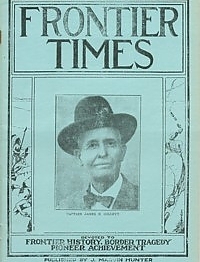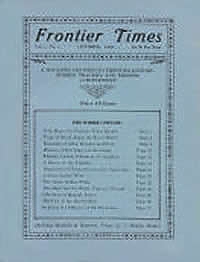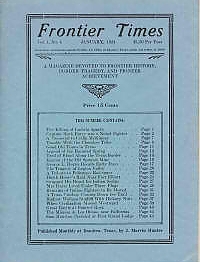By using our website, you agree to the use of cookies as described in our Cookie Policy
Magazines & Instant Downloads
Vol 10 No. 12 - September 1933
Captain James B. Gillett – (Cover Image)
Captain James Buchanan Gillett of Marfa, Texas was identified with the livestock industry and ranching business of the Big Bend and Davis Mountains region, and was highly esteemed by all of the people of West Texas. He was born at Austin, Texas, November 1, 1856. Gillett saw much service in Nimble, Mason, Menard, Kerr, San. Saba, Llano, Lampasas, Burnet and other counties, fighting Indians, and running outlaws to earth. After serving many useful years in Ranger service, Joined the El Paso police force, afterwards becoming chief of police. In 1885 he resigned that position and went with the Estrada Land and Cattle Company, in charge of their large ranch, twenty-five miles from Alpine, in which position he remained for five years, and then resigned to take charge of his own ranch near Marfa. In 1900 he sold out and went to Hoswell, New Mexico, and ranched there until 1907, when he sold out there and returned to Marfa county, buying the Barrell Springs Ranch, of more than thirty thousand acres.
Further Mentions: Captain Neal Coldwell; Captain V. U. Reynolds; Captain D. W. Roberts, in Menard County, serving with Company D; Major John B. Jones; Sam Bass; Captain Pat Dolan, commander of Company F; Lieutenant Baylor's Company...
Dedication of a Memorial Tablet
Account of old Camp Verde, Texas, located 12 miles north of Bandera. Camp Verde, (called Fort Verde), was one of a chain of military posts established by the United States in Western Texas after the annexation of Texas in 1818, for the protection of settlers aginst Hostile Indians. It was established as a military post July 8, 1856, and was located on the north bank of Verde Creek, a branch of the Guadalupee river, half a mile west of the old Johnson Road, leading from San Antonio to Fort Terrett. The post was continuously garrisoned until March 7, 1861, when it was captured by the Confederate forces, the United States troops withdrawing. It was reoccupied by Federal troops at the close of the war between the States, and finally abandoned November 30, 1869.
This account is rich in names of commanding officers and others associated with the history of the fort:
Captain I. N. Palmer, 2nd Cavalry, July 1856 to May 1858; 2nd Lieutenant W. M. Graham, 1st Artillery, May to August, 1858; Captain J. H. King, 1st Infantry, August, 1858, to February, 1859; 2nd Lieutenant .J. H. Holman, 1st Infantry, 1859, . 2nd lieutenant W. Graham, February to June, 1859; Major S. P. Heintzelman, 1st Infantry, June, 1859, to November, 1.860; Captain J. N. Caldwell, 1st Infantry, December to January, 1.861; Colonel C. A. Waite, 1st Infantry, January to February, 1.861., Captain J. N. Caldwell, 1st; Infantry, February 1861. It was from Camp Verde that Colonel Albert Sidney Johnston was ordered to Utah in 1857 to quell the .Mormon revolt. The illustrious Robert E. Lee, then a Lieutenant-Colonel in the United States army, was at Camp Verde a number of times.
Further Mentions: a residence and is now owned and occupied by Mr. and Mrs. R. W. Nowlin; Chaplain Chas. W. B. Hill, Major U. S. Army; Mrs. Whit Boyd, Past President Texas Division United Daughters of the Confederacy; Judge Frost Woodhull for Bexar County; Hon. Julius Real for Kerr County; Hon. J. Marvin Hunter for Bandera County; C. H. Rhodes; Chris. Emmett; Harry Futrelle; Mrs. W. W. Turner; Judge J. S. Atkins, County Judge of Kerr County; R. W. Nowlin; Jules Verne Allen; Rev. Bishop W. T. Capers; Mrs. John King Beretta;
The Camel Experiment
Chris Emmett. Account of Major Henry Constantino Wayne and our government's experiment with the camels in the Texas frontier in 1855. It was a dream unfulfilled. It was a scheme based upon wisdom; one calculated to inaugurate an entire new scheme of transportation, the result of which world have been the opening, for earlier settlement, one half of our western continent. It failed, but the failure was from causes wholly extraneous to itself.
Further Mentions: Lt. David Dixon Porter; San Pedro Park, in San Antonio; Captain I. N. Palmer; Bethel Coopwood ; and David Newton Wharton
LETTERS OF AN EARLY AMERICAN TRAVELER, MARY AUSTIN HOLLEY
By Mattie Austin Hatcher.
More than a century ago there came to Texas a remarkable woman, Mary Austin Holley. She possessed in a large degree the facility to describe her impressions of her cousin's colony, for such was her relationship to Stephen F. Austin, and she had an insight into the needs of the colonists that was almost uncanny. She wrote letters to her relatives and to her many friends in various places and she told them of the beauties of the new country, of its advantages, of its unlimited possibilities. Mrs. Starkey Duncan
Sudden Floods in Texas
COLONEL MERRIAM, of the 24th infantry United States army, with his family and an escort, encamped on the Concho River on Sunday, the 24th day of April, 1870. This river is formed by the junction of the rills of water from several large springs. The stream at its head is so small that a man can step across it anywhere. The tops of the bank, are usually about twenty-five feet above the water. Fatigued with their journey, the party was pleasantly resting, when early in the evening Colonel Merriam saw signs of the coming storm. The tent was fastened, and, and made as secure as possible, and about nine o'clock a hail storm burst `upon them, accompanied with some rain and strong wind. The fall of hail was unprecedented, lasting until eleven o'clock, the stones being of the size of hen's eggs, and striking the tent with a noise like that of incessant musketry. The colonel, who was not ignorant of the sudden and extreme overflows to which the mountain streams of Texas are liable, went out into the darkness as soon as the storm had ceased, to see what effect had been produced on the rivulet. To his amazement he found, in the formerly almost dry bed of the creek, a resistless torrent, loaded and filled with hail, rolling nearly bank full, white like milk, and silent as a river of oil. He at once saw the aid of three men started to run with it to the higher ground, a distance of not more than sixty yards. Scarcely a minute had elapsed from the time the alarm had been given, but the water had already surged over the banks in waves of such volume and force, as to sweep the party from their feet before they had traversed thirty yards. The colonel called for assistance upon some cavalry soldiers, who had just escaped from the United States mail station near by, but they were too terror-stricken to heed. Colonel Merriam then gave up the hope of saving his family in the carriage, and tried to spring into it, intending to swim out with them; but the icy torrent instantly swept him away. Being an expert swimmer, he succeeded in reaching the bank two hundred yards below, and ran back to renew the attempt to save his dear ones, when he received the awful tidings, that the moment he was borne away by the stream, the carriage, with all its precious freight, turned over and went rolling down the flood; his wife saying, as she disappeared, "My darling husband, good-by." The little rill of a few hours before, which a child might step across, had become a raging river near a mile in width, from thirty to forty feet deep, and covered with masses of drift-wood. The bereaved husband procured a horse from one of the cavalry, and rode far down the…"
George W. Saunders My Friend
By Frank J. Dobie. Account of well-known San Antonio area cattleman. The name of Saunders is inseparably linked with the old trail-driving days of the cattle industry. At 17, he drove his first, herd across the plains, through swollen rivers and past the menace of Indians to the market at Abilene, Kansas. As the ranks of the band of pioneers were thinned by time, in 1915 he was the founder of the Old Trail Drivers Association and, two years later was elected president, a position he held continuously thereafter. Saunders was born at Rancho, Gonzales County, February 12, 1854. His parents came by ox wagon from Mississippi. When he was five, the family moved to Goliad County and the lad rode a pony and helped keep up the tail end of the herd. While his father and oldest brother were serving in the Confederate Army, young George and another brother looked after the cattle. Suanders became a Texas legend. This is Dobie’s account of their personal friendship.
Further Mentions: Bob Lauderdale; Charlie Johnson; Charco, Texas; Carl Ackley; Louis Schreiner at Kerrville
CLARKSVILLE CHURCH 100 YEARS OLD
Sunday, June 4, marked the one hundredth anniversary of the organization of the Presbyterian Church at Clarksville, Red River county. The church was organized in 1833 by a band of sturdy Tennessee pioneers about four miles from its present location. This church, organized in the early days, is perhaps the oldest Protestant organization in Texas or the Southwest.
Texas Has a Wonderful History
Interesting brief account of the characteristics and temperaments of the greats who early formed the history of Texas.
Further Mentions: Aaron Burr; Magee, Kemper, Gutierez, Perry; Dr. Long; Jean Lafitte of Bordeaux; Claiborne;
The Archive War
George H. Gray. EARLY IN MARCH, 1842, the Mexican forces under General Vasquez made an incursion into Texas, which was promptly met by the people, and the invaders driven back. President Houston, deeming the national archives in danger from the enemy, felt it his duty to order their removal, as well as the removal of the government offices to a place of safety. Accordingly he ordered their prompt removal to Houston. This gave rise to what is known as the Archive war, the result of which has been the location of the seat of government at Austin up to this time. This is the account of that bloodless, but effective "war".
Further Mentions: Mrs. Eberly; the Eberly House, now owned by Mrs. Beale; Captain M. B. Lewis; Brushy Creek, eighteen miles north-east of Austin;
FRONTIERSMAN, 84 RIDES HORSEBACK
"Bob" Thompson, an 84-year-old veteran of frontier days in Texas, passed through here Thursday, riding his horse-a youthful sparkle in his eyes-on his way to Henry Miller's, his brother-in-law, from Utopia, his home, which is about a 50 mile ride, and he rode it that day. "Uncle Bob" came back here Saturday, on his return home, and stayed over till Sunday with Charlie Dulaney, when he continued his journey home.
The old residents here: Ed Kelly, "Uncle Doe" Dulaney and others have known "Uncle Bob" so long, and loved him, that they fell right in with him, in brotherly affection. Ed Kelly said he worked for him when he was "a little boy," and the old frontiersman is known and loved by lots of Leakey folks…
CHEROKEE COUNTY ONCE HAD WOODEN RAILROAD
Cherokee county once boasted a fifteen-mile railroad line built entirely of hardwood rails. The line has long been abandoned and the rails torn up, but some of the grading remains. The history of the wooden rail line dates back more than half a century. In the early days of the development of Cherokee county, Jacksonville became a shipping center but had no direct railroad connection with Rusk, the county seat. Only a dirt highway connected the two towns and Jacksonville…etc.
Early History of Texas
Texas Almanac, 1873. This (and the following article) is an excellent overview of the leading events and character in Texas history. A good place to go for an overall perspective and to gain a feel for the grand sweep of the history of this great state. These two articles would make an excellent addition to your child’s school curriculum.
Texas Historical Incidents
This (and the previous article) is an excellent overview of the leading events and character in Texas history. A good place to go for an overall perspective and to gain a feel for the grand sweep of the history of this great state.
Captain Henry S. Brown
Henry S. Brown was an early and well known pioneer of Texas, was born in Madison county, Kentucky, March 8, 1793, and remained there until 1810, when the spirit of adventure, characteristic of him through life, led him, friendless and alone, to the wilds of Missouri, in which territory he took up his abode in St. Charles county. Eventually Brown settled in Texas making his headquarters at Brazoria, Gonzales and San Antonio. Having located at Columbia in 1832, he was called to the command of the largest company (about eighty men and boys,) in the bloody battle of Velasco on June 26, 1832. His gallantry on that occasion was for years the theme of praise by his surviving comrades His life was one akin to the legends of romance, and won for him among the early pioneers of Texas the character of a brave, chivralous, and sagacious border chief. His heart was warm and generous to a fault, but throughout those years his habits were sober, his intercourse with others honorable, and he rarely ever had a difficulty with his fellow man. Misfortune often attended him, and lie several times lost heavily by the Indians. In 1833 Captain Brown was again in the West, and had several adventures with both Indians and border Mexicans. It was often said by old citizens that he had more contests with the Indians, and was more generally successful, than any of the brave pioneer citizens of that day. He died in Columbia July 26, 1834, and his memory is honorably perpetuated in the name of the prosperous county of Brown, which was named in his honor. Rufus E. Brown, an early Kendall county citizen, and John Henry Brown, the historian, were his sons., R. T. Brown of Glendale, Arizona, and Henry T. Brown of Deming, New Mexico, are grandsons.
Further Mentions: Fort Clark, on the Illinois River; a younger brother, John, afterward known as Waco Brown; Thomas Jameson, James Musick, and Andrew Scott; a war party of seventeen Wacos on Cumming's Creek, now in Fayette county; Colonel Wm. T. Austin, Colonel John A. Wharton;
Five Years a Cavalryman
By H. H. McConnell. Ongoing, detailed and day-to-day journal recounting McConnell’s experiences are further related in this installment of his excellent story. To read this account is like being along for the ride. Frontier history comes alive in these pages, from the back of a great Calvaryman’s horse. (Continued from Last .Month.)
Further Mentions: an old Prussian soldier named Stroop; Elm Creek, a stream of considerable volume that empties into the Brazos about six or seven miles above Belknap; On one occasion we caught one yellow catfish that weighed forty-six pounds and measured over four feet in, length the three largest, including this one, weighed one hundred and twenty-one pounds; About sunset we arrived in camp, and weighing our spoils found we had over five hundred pounds of fish, besides turtles. One of our buffalo fish weighed twenty-eight pounds and was a beauty to look at. Surely, I thought, nature had been prodigal here; besides the glorious climate and balmy air, and gorgeous skies, she had produced whopping catfish also; The regimental sutler or post-trader, D. A. Wray, of Pittsburg, Pennsylvania, had branch stores at all posts occupied by companies of the regiment; Major Whitesides (the Quartermaster); Buffalo Springs; Colonel Marcy; Jacksboro; Mrs. Chas; Victoria Peak; company clerk, one Ryan by name; a soldier by name of Paddy Clarke; Jim Furrey; Bob Fawls; Major Hutchins; Doc Cooper; Old Turner and Appleby; Mike Keher. Romance Had Role in Founding of Corpus Christi Coleman McCampbell, Corpus Christi, Texas.
Few Texas towns have a more interesting or colorful background than Corpus Christi. But a fact little known is that romance played an important role in its founding. The incident is concerning Col. H. L. Kinney, the adventurous founder of Corpus Christi. He was a true product of his time and he will be remembered as rancher, smuggler, politican, diplomat, benefactor, adventurer, colonizer and soldier, but he also for a brief time, sought the hand of the lovely daughter of Daniel Webster, but was denied. This led to Kinney’s removal from Peru, Ill to Mexico and subsequently to his great efforts in Corpus Christi. This account describes not only the romance, but many of the details surrounding Kinney’s role in the establishment of the city.
Further Mentions: Anna M. Brooks; Nathaniel J. Brown; Prof. A. A. Brooks; Alvarez de Pirteda; Rancho del Oso; Jose M. Carvajal; Dr. Ashbel Smith; William Walker;
GRADUATE AT THE AGE OF 77
Sam P. Cochran of Dallas, second ranking Scottish Rite Mason in America, and the only man known to have a statue erected to his honor while still living, was admitted to the bar and graduated from law school at the age of 77. He was valedictorian of his class, just 60 years after he was valedictorian of his high school class in 1873. The statue of Mr. Cochran stands on the lawn of the Dallas Masonic temple.
Second Cavalry Once at Camp Verde
THE SECOND United States Cavalry was organized in 1855. It was one of four regiments, two of cavalry and two of infantry, which were added to the armed forces of the country at that time. The Secretary of War, Jefferson Davis, personally selected the officers for the cavalry regiments, and their commissions bore date of March 3, 1855. The First Cavalry was recruited in the East, but the Second, which was destined for the frontier of Texas, was recruited in the then mid-Western States, as fine a section, surely, as could have been selected for the enlistment of men suited to frontier service. This is the account.
Further Mentions: Lieutenant William P. Chambliss, N. C. Evans, Richard W. Johnson, Fritzhugh Lee, Chas. Field, and John B. Hood ; Captains Innis Palmer, George Stoneman, James Oakes, Theodore.0'Hara, Albert G. Brackett, Earl Van Dorn, and E. Kirby Smith; Majors William II. Emory, George H. Thomas and William J. Hardee; Lieutenant Colonel Robert E. Lee and Col. Albert Sidney Johnston; William P. Chambliss; Newton Palmer; Nathan U. Evans; Richard W. Johnson; James Oakes; John B. Hood; Marshal Ney; George Stoneman; Theodore O'Hara; Albert G. Brackett; William H. Emory; William J. Hardee; George H. Thomas, "Rock of Chickamauga,"; Gamaliel Bradford;
R. E. LEE'S RAZOR OWNED BY WHITESBORO WOMAN
Museum keepers and connoisseurs of historical relies will probably take particular note of an article that belongs to a Whitesboro family. The article is a razor that was the property of General Robert E. Lee, much beloved by the nation. The razor is now in possession of Mrs. W. H. Meek, a great granddaughter of the famous general, who resides one mile northeast of Whitesboro.
Mr. Meek said he did not recall just when his family got the razor but that it was inherited by Mrs. Meek's father, a grandson of General Lee. The article is distinctly old style, straight blade, has never been hollow ground, and is extra heavy.
The razor is highly prized by the present owners and has been the cause of many expressions of surprise by the hundreds who have seen it the past few years. Mrs. Meek's name before her marriage was American Jane Lee.
$4.95
‹ Back








